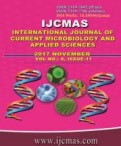


 National Academy of Agricultural Sciences (NAAS)
National Academy of Agricultural Sciences (NAAS)

|
PRINT ISSN : 2319-7692
Online ISSN : 2319-7706 Issues : 12 per year Publisher : Excellent Publishers Email : editorijcmas@gmail.com / submit@ijcmas.com Editor-in-chief: Dr.M.Prakash Index Copernicus ICV 2018: 95.39 NAAS RATING 2020: 5.38 |
Field experiments were conducted on a fixed site of Conservation Agriculture Project at main Agricultural Research Station, University of Agricultural Sciences, Dharwad, during 2014-15 and 2015-16 to study the effect of conservation tillage and land configuration on growth and yield of cotton under rainfed situations. The experimental findings showed that, all the conservation tillage systems viz, No tillage with broad bed and furrow (BBF) and crop residues retained on the surface, reduced tillage with BBF and incorporation of crop residues, no tillage with crop residues retained on the surface and reduced tillage with flat bed with incorporation of crop residues recorded significantly higher growth and yield parameters as compared to conventional tillage systems. No tillage with broad bed and furrow (BBF) and crop residues retained on the surface and reduced tillage with BBF and incorporation of crop residues produced significantly higher kapas weight (150.78 and 150.72 g plant-1, respectively) and seed cotton yield (1,756 and 1,743 kg ha-1, respectively) over conventional tillage with incorporation of crop residues (145.42 g plant-1 and 1,572 kg ha-1, respectively) and conventional tillage without crop residues (139.26 g plant-1 and 1,324 kg ha-1, respectively).
 |
 |
 |
 |
 |